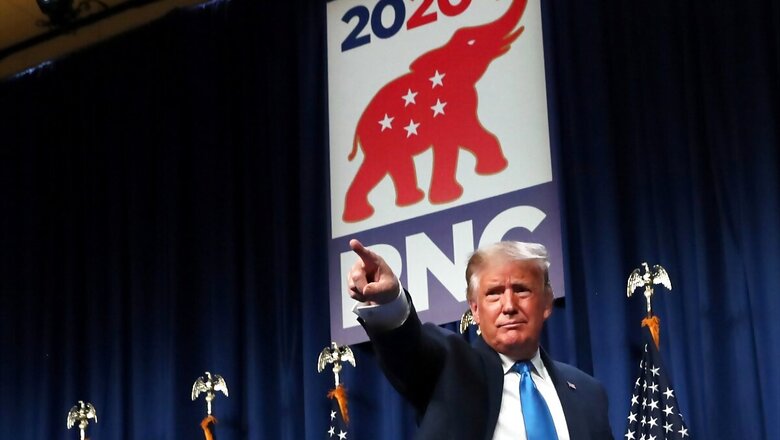
views
US President Donald Trump is heading into the general election with the worst jobs numbers of any president, based on records that go back to World War II.
That’s not going to change in the two months between now and Election Day, no matter how the economy does.
The US economy is down 4.7 million jobs since January 2017 when Trump took office, according to the Labor Department.
The August jobs report released Friday showed employers added back about 1.4 million jobs, bringing the unemployment rate to 8.4%. That is still well short of what would be needed to give Trump a positive jobs record by November 3.
The only other President in the last 80 years to own an overall loss in jobs between his inauguration and the following Election Day was George W. Bush in 2004. That was because of the so-called “jobless recovery” after the recession sparked by the dot-com bust. But the loss of 605,000 jobs through September of 2004 was a fraction of the job losses that happened under the Trump administration.
To be sure, the bulk of the job losses in the Trump economy were precipitated by the shutdown orders associated with the worst pandemic in 100 years.
“I would say Covid-19 is one hell of an extenuating circumstance,” said Greg Valliere, chief US policy strategist for AGF Investments.
But there are many who question whether the Trump administration’s handling of the pandemic is responsible for deeper economic damage than would have taken place had the White House taken a more active role in fighting coronavirus. And even with millions being called back to work in recent months, there were more were 13.6 million people looking for work and unable to find one in the most recent reading.
There is only one more jobs report — for September — that will be released before Election Day, and the Labor Department will start counting the jobs that make up that report next week. Even if Congress pushes through another Covid-19 financial stimulus package soon, it won’t wipe out all of the job losses that have occurred during Trump’s term.
[hq]Trump’s Modest jobs record before the pandemic[/hq]
President Trump has frequently boasted about his pre-pandemic jobs record. And he has promised that once the pandemic is over, the job gains will return.
But data show that his administration’s job gains before the pandemic were only average compared with predecessors.
There were 6.8 million jobs added between the inauguration and February of this year, a 5% gain from when Trump took office. Measured by percentage, that’s only the 11th best record out of the last 20 presidential terms. (Percentage gain is the best way to take into account the population growth over the last 80 years.)
The best percentage gain was in the period between 1941 and 1944, when the end of the Great Depression and the nation’s entry into World War II resulted in a 21% gain in jobs during President Franklin D. Roosevelt’s third term.
[hq]Effect of job losses on past votes[/hq]
This doesn’t necessarily mean that Trump will be joining the ranks of unemployed.
The direction of the economy can be far more important than the raw numbers, said Valliere. That could be good news for Trump since in the last four months employers have brought back 10.6 million workers who were temporarily laid off earlier in the year.
“The direction in unemployment in all likelihood will be in Trump’s favor,” he said earlier this week. “If we get more than a million jobs added back on Friday and unemployment drops below 10%, you know he’s going to brag about numbers like that.”
George W. Bush, the only president with a record of job losses leading up to the election, was nonetheless reelected in 2004. He was helped by the economy adding 1.5 million jobs between January and September of that year.
By contrast, even a good overall jobs record can be hurt by job losses leading up to the election. Jimmy Carter had one of the best job creation records between his inaugural and September of 1980 — 9.5 million jobs added, a gain of nearly 12%. But throughout 1980, job losses mounted as employers cut nearly 800,000 jobs between March and September. That, along with high inflation and the Iran hostage crisis, led to his defeat.
[hq]’Problems on the horizon’ [/hq]
The job rebound appears to be slowing, as many of the jobs that were easy to bring back are already back, said Mark Zandi, chief economist with Moody’s Analytics. The 1.4 million jobs added in August was down from the 1.7 million added in July, as the CNN Business Recovery Dashboard shows.
Many of the millions of people who are out of work may be losing faith that they will be getting their jobs back. The 10.6 million people who returned to the jobs were mostly working in restaurants, hotels and retailers, noted Zandi.
“That will only carry the job recovery so far,” he said. “There is evidence that things are slowing. And there are problems on the horizon.”
Airlines are about to start cutting jobs. Local and state governments are running out of money. The damage is still accumulating, Zandi argued.
So what does that mean for Trump’s re-election chances? “I think people are still making up their minds,” said Zandi. He said that’s why the August and September jobs reports matter.
“Do they view it as glass half full glass half empty?” he asked.


















Comments
0 comment